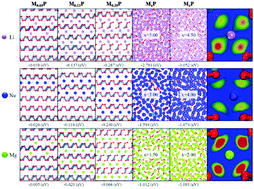A Comparative First-Principles Study of the Lithiation, Sodiation, and Magnesiation of Black Phosphorus for Li-, Na-, and Mg-Ion Batteries
슈퍼관리자
2021-05-21
A Comparative First-Principles Study of the Lithiation, Sodiation, and Magnesiation of Black Phosphorus for Li-, Na-, and Mg-Ion Batteries
-
Authors :
Kailash P. S. S. Hembram, Hyun Jung; Byung Chul Yeo; Sung Jin Pai, Heon Ju Lee, Kwang-Ryeol Lee, Sang Soo Han
-
Journal :
Phys. Chem. Chem. Phys.
-
Vol :
18
-
Page :
21391-21397
-
Year :
2016

Abstract
Using first-principles calculations, we describe and compare atomistic lithiation, sodiation, and magnesiation processes in black phosphorous with a layered structure similar to graphite for Li-, Na-, and Mg-ion batteries because graphite is not considered to be an electrode material for Na- and Mg-ion batteries. The three processes are similar in that an intercalation mechanism occurs at low Li/Na/Mg concentrations, and then further insertion of Li/Na/Mg leads to a change from the intercalation mechanism to an alloying process. Li and Mg show a columnar intercalation mechanism and prefer to locate in different phosphorene layers, while Na shows a planar intercalation mechanism and preferentially localizes in the same layer. In addition, we compare the mechanical properties of black phosphorous during lithiation, sodiation, and magnesiation. Interestingly, lithiation and sodiation at high concentrations (Li2P and Na2P) lead to the softening of black phosphorous, whereas magnesiation shows a hardening phenomenon. In addition, the diffusion of Li/Na/Mg in black phosphorus during the intercalation process is an easy process along one-dimensional channels in black phosphorus with marginal energy barriers. The diffusion of Li has a lower energy barrier in black phosphorus than in graphite.















